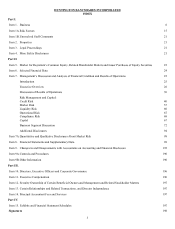Huntington National Bank 2012 Annual Report Download - page 21
Download and view the complete annual report
Please find page 21 of the 2012 Huntington National Bank annual report below. You can navigate through the pages in the report by either clicking on the pages listed below, or by using the keyword search tool below to find specific information within the annual report.13
FDICIA generally prohibits a depository institution from making any capital distribution, including payment of a cash dividend or
paying any management fee to its holding company, if the depository institution would become under-capitalized after such payment.
Under-capitalized institutions are also subject to growth limitations and are required by the appropriate federal banking agency to
submit a capital restoration plan. If any depository institution subsidiary of a holding company is required to submit a capital
restoration plan, the holding company would be required to provide a limited guarantee regarding compliance with the plan as a
condition of approval of such plan.
Depending upon the severity of the under capitalization, the under-capitalized institutions may be subject to a number of
requirements and restrictions, including orders to sell sufficient voting stock to become adequately-capitalized, requirements to reduce
total assets, cessation of receipt of deposits from correspondent banks, and restrictions on making any payment of principal or interest
on their subordinated debt. Critically under-capitalized institutions are subject to appointment of a receiver or conservator within 90
days of becoming so classified.
Under FDICIA, a depository institution that is not well-capitalized is generally prohibited from accepting brokered deposits and
offering interest rates on deposits higher than the prevailing rate in its market. Since the Bank is well-capitalized, the FDICIA
brokered deposit rule did not adversely affect its ability to accept brokered deposits. The Bank had $1.6 billion of such brokered
deposits at December 31, 2012.
In June 2012, the FRB, OCC, and FDIC (collectively, the Agencies) each issued Notices of Proposed Rulemaking (NPRs) that
would revise and replace the Agencies’ current capital rules to align with the BASEL III capital standards and meet certain
requirements of the Dodd-Frank Act. Certain requirements of the NPRs would establish more restrictive capital definitions, higher
risk-weightings for certain asset classes, capital buffers and higher minimum capital ratios. The NPRs were in a comment period
through October 22, 2012, and those comments are currently being evaluated by the Agencies.
At the time of the NPR release, we evaluated the impact of the NPRs as proposed on our regulatory capital ratios and we
estimated a reduction of approximately 150 basis points to our BASEL I Tier I Common risk-based capital ratio based on our June 30,
2012 balance sheet composition. We anticipate that our capital ratios, on a BASEL III basis, would continue to exceed the well-
capitalized minimum requirements. We are evaluating options to mitigate the capital impact of the NPRs and will provide further
guidance upon issuance of final rules by the Agencies.
As a bank holding company, we must act as a source of financial and managerial strength to the Bank and the Bank is subject to
affiliate transaction restrictions.
Under the Dodd-Frank Act, a bank holding company must act as a source of financial and managerial strength to each of its
subsidiary banks and must commit resources to support each such subsidiary bank. The Federal Reserve may require a bank holding
company to make capital injections into a troubled subsidiary bank. It may charge the bank holding company with engaging in unsafe
and unsound practices if the bank holding company fails to commit resources to such a subsidiary bank or if it undertakes actions that
the Federal Reserve believes might jeopardize the bank holding company’s ability to commit resources to such subsidiary bank.
Any loans by a holding company to a subsidiary bank are subordinate in right of payment to deposits and to certain other
indebtedness of such subsidiary bank. In the event of a bank holding company's bankruptcy, an appointed bankruptcy trustee will
assume any commitment by the holding company to a federal bank regulatory agency to maintain the capital of a subsidiary bank.
Moreover, the bankruptcy law provides that claims based on any such commitment will be entitled to a priority of payment over the
claims of the institution's general unsecured creditors, including the holders of its note obligations.
Federal law permits the OCC to order the pro-rata assessment of shareholders of a national bank whose capital stock has become
impaired, by losses or otherwise, to relieve a deficiency in such national bank’s capital stock. This statute also provides for the
enforcement of any such pro-rata assessment of shareholders of such national bank to cover such impairment of capital stock by sale,
to the extent necessary, of the capital stock owned by any assessed shareholder failing to pay the assessment. As the sole shareholder
of the Bank, we are subject to such provisions.
Moreover, the claims of a receiver of an insured depository institution for administrative expenses and the claims of holders of
deposit liabilities of such an institution are accorded priority over the claims of general unsecured creditors of such an institution,
including the holders of the institution's note obligations, in the event of liquidation or other resolution of such institution. Claims of a
receiver for administrative expenses and claims of holders of deposit liabilities of the Bank, including the FDIC as the insurer of such
holders, would receive priority over the holders of notes and other senior debt of the Bank in the event of liquidation or other
resolution and over our interests as sole shareholder of the Bank.
























